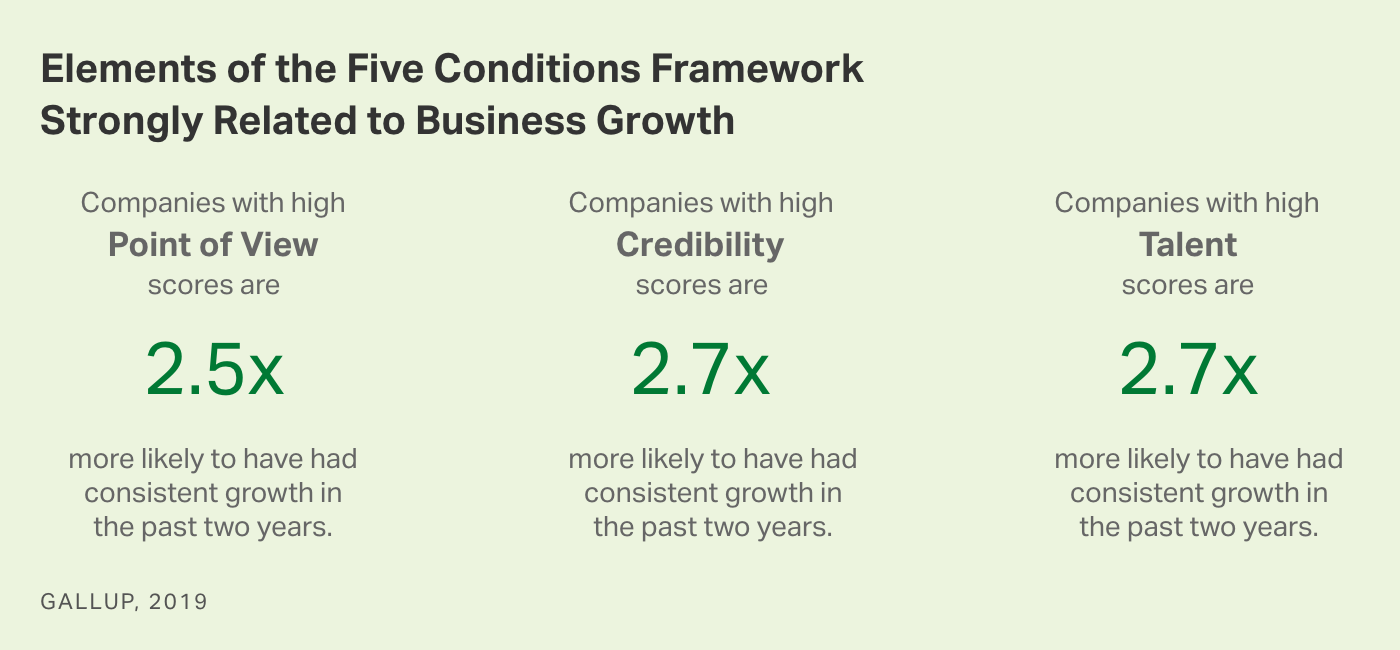A new study by Gallup and TrueSpace looks at the conditions post-startup companies need in order to make the transition from the treacherous "adolescent" phase of rapid but sporadic and unpredictable growth to a more stable developmental phase. The results from 2,494 business owners on the Five Conditions Assessment (5CA) show how their companies' growth performance relates to systems that help them understand the drivers of growth, monitor factors most likely to influence it and make continual adjustments to how it allocates time, talent and capital to improve predictability and reduce risk.
The first article on the Gallup/TrueSpace study provides an overview of the broad concepts addressed by the Five Conditions framework. Here we look at three specific factors that are among the most strongly related to recent growth performance among companies in the study:
-
A clear, compelling point of view directed toward the target market. Companies with high Point of View scores are 2.5 times more likely than others to have had revenue growth of at least 10% in each of the past two years.
-
Intentional strategies for acquiring and developing talent. Companies with high Talent scores are 2.7 times more likely than others to have grown at least 10% in each of the past two years.
-
High levels of trust among employees and other stakeholders in the credibility of the organization's leaders. Companies with high Credibility scores are also 2.7 times more likely than others to have grown at least 10% in each of the past two years.
The 5CA is designed to measure the growth potential of post-startup businesses -- those that have survived their first three years and have at least $2 million in annual revenue but have not yet reached the lower mid-market threshold of $10 million. The more than 2 million companies in this fledgling group have the potential to create millions of new jobs if they can achieve consistent, long-term growth -- but they are less likely than startups or larger businesses to capture the attention of investors, policymakers and the media.
The framework for the 5CA borrows from System Dynamics, a field brought to the mainstream by the late Professor Jay Forrester of MIT. This involves evaluating businesses by seeing them as a series of feedback systems. Each of the Five Conditions represents a broad requirement for predictable performance and consistent growth. Within each Condition is a set of feedback loops, and each loop includes specific elements that can increase or diminish a business' growth potential. Once a business is modeled in this manner, limits to its growth become visible, and entrepreneurs can act and make decisions with more precision.
For example, one of the feedback loops in the Alignment condition is Focus -- the extent to which the company's resources are focused on a clearly defined target market and broadly understood objectives. Within that loop, the 5CA addresses four elements -- labeled Market, Point of View, Customers and Talent -- that can change the organization's level of Focus.

Point of View and Talent are among the three elements (out of 30 overall in the framework) most strongly related to businesses' growth performance over the past two years. A closer look at these elements gives one a better idea of how the 5CA measures the concepts associated with the Five Conditions. See Appendix A in the Five Conditions Assessment report to find out where each of these elements fits into the overall framework.
Condition: Alignment → Feedback Loop: Focus → Element: Point of View
In order to align a company's resources for high performance, leaders must first develop, promote and sustain a point of view that distinguishes the company from others in the industry. Critically, that point of view isn't just a sales tactic -- it's a system that governs how customers, employees and partners perceive the business, helping them focus on the needs of high-value customers while removing nontarget customers from consideration.
A distinctive point of view also purposely alters risk perception by enabling companies to demonstrate credibility, position themselves as trusted providers and become recognized as the best -- the lowest-risk, highest-value option -- in their niche. For businesses that are not market leaders, a point of view serves as the only effective and sustainable mechanism for providing high-value customers the assurance they need to feel confident in changing from the status quo. Specific 5CA questions addressing Point of View include:
- Is the company a thought leader in its industry?
- Do customers view the company as a low-risk choice?
- Has the company differentiated its products or services enough to avoid competing on price alone?
Condition: Alignment → Feedback Loop: Focus → Element: Talent
Companies that are building the capacity for consistent growth clearly recognize the central role of talent in achieving it. Role definitions and expectations are clarified and formalized, which makes it easier to identify specific talent needs. Finding and selecting employees with the skills and experience valued by the target market becomes a full-time effort.
Once they have effective processes for finding and hiring new talent, high-performing companies shift their focus to development and retention. Leaders recognize that talent development -- rather than just talent acquisition -- is a critical driver of growth, and opportunities for personal growth and development become part of the value proposition it presents to prospective employees. Specific 5CA questions addressing talent include:
- Is finding, selecting and developing talent a core strategy?
- Does the company offer opportunities for employees to advance in terms of roles and responsibilities?
- Does the company provide formal role-based training opportunities to employees?
Condition: Endurance → Feedback Loop: Engagement → Element: Credibility
The Credibility element measures employees' confidence in the future of the company and the entrepreneur's or CEO's ability to lead it there. This relationship demonstrates one accumulating advantage of businesses that achieve repeated growth periods: The resulting credibility bolsters confidence among employees and shareholders for the longer-term growth journey. High-performing companies recognize the importance of leadership credibility and use employee feedback systems to track it.
Importantly, leadership credibility is bolstered not just by the entrepreneurs' own experience and abilities, but also by their willingness to seek advice and to hire outside leadership talent when needed. Ultimately, credibility is determined by whether the leadership has found a way to consistently meet performance expectations. Specific 5CA questions addressing credibility include:
- Are employees confident that the company will meet or exceed its annual performance forecast?
- Do executives have processes for assessing credibility with employees and shareholders?
For more information about the Five Conditions Assessment, please download the full report from TrueSpace and Gallup, or visit www.truespace.com.




